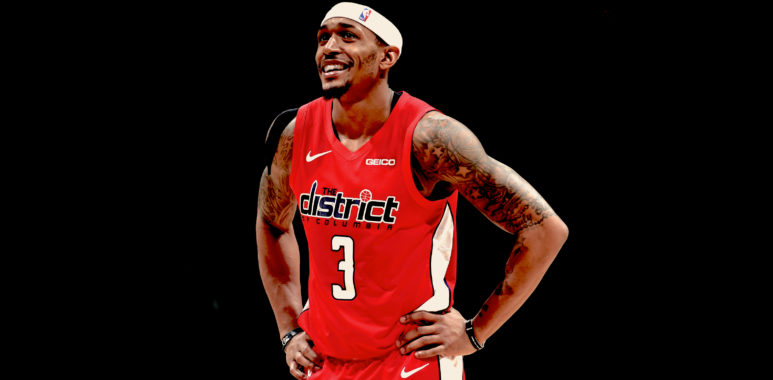
Washington Wizards: Three takeaways from January
With their win last night against the Indiana Pacers, the Washington Wizards finished January a cool 8-6. The winning month registered as their best this season and notably coincided with the absence of franchise star John Wall.
The Wizards have played better basketball without Wall – though playing better and being better aren’t necessarily the same thing. At 22-29, they’re still 2.5 games back of a playoff berth, and if they do manage to make the postseason, it’ll be a quick exit.
Enough with the cynicism, though. The Wizards finished up the first month of 2019 having outscored opponents by 3.5 points per 100 possessions, 11th in the league. They’re no longer a bad team, even if injuries to Wall, Markieff Morris, and Dwight Howard leave them light on talent.
Here are three takeaways from a mostly positive January.
The Wizards Are Moving the Ball
No secret here: removing a ball-pounder like John Wall means more ball movement, for better or worse. The Kentucky man is an electric playmaker, but he was one of the only players in Washington’s lineup who needed the ball.
Washington averaged just 283 passes per game through the first three months of the season, 26th in the Association. That number shot up to 314 in January – a top-five mark – with nearly two-thirds of all made baskets assisted.
Bradley Beal has assumed the reigns as Washington’s primary pick-and-roll threat, but unlike his fellow star, he can become an off-ball threat and give others the chance to run the show. Tomas Satoransky isn’t a drive-and-kick dynamo, but he’s a steady game manager who’s secure with the rock. His 3.3 assist-to-turnover ratio is an elite mark for a lead guard.
But neither Wall nor Satoransky are natural floor generals. The offense has instead stayed churning with the work of forwards capable of facilitating a motion offense. Jeff Green, whose glue-guy skillset I detailed last month, knits together the offense at the top of the key and picks out cutters:
powered by Advanced iFrame free. Get the Pro version on CodeCanyon.
Trevor Ariza has also been a wily ball-mover, his 4.1 assists per game in January dwarfing his career numbers. He’ll take a defense beginning to crack and rip the seams wide open with a clever extra pass:
powered by Advanced iFrame free. Get the Pro version on CodeCanyon.
The Wizards are moving the ball constantly and playing freely. When it all works out, it’s a real thing of beauty:
powered by Advanced iFrame free. Get the Pro version on CodeCanyon.
The Threes Finally Went In
Rims were not kind to the Wizards for the first three months of the season. The team canned just 32.8 percent of its three-pointers through December, third-worst in the league. The only teams hitting fewer threes than the Wiz were Detroit and Oklahoma City, two squads with multiple high-volume, low-efficiency shooters.
Washington, unlike that bricky duo, was just unlucky. Scott Brooks’ men rank a respectable 12th in perimeter shooting talent, per BBall Index’s talent grades. But they wasted the easiest opportunities in 2018, sinking just 34.6 percent of wide open threes, lower than league average on all threes.
That number spiked to 44.0 percent in January, resulting in more made bunnies per game despite the squad taking fewer attempts. Altogether, the team shot 39.0 percent from three in January, sixth in the league.
Washington’s ball movement could be making a difference; knowing you may have to fire at any time might mean less hesitation and more comfort. But it’s also possible the Wiz are just riding a wave of good luck after succumbing to three months of the opposite.
Either way, they need the threes to continue falling.
Thomas Bryant Is a Keeper
The sample size has grown large enough. Even without a point guard in John Wall who can guide passes through the most treacherous lanes, Thomas Bryant has still provided easy flushes and constant energy for the Wizards. He may not be any better than a low-end starter – not all that valuable in a league bloated with centers – but the 21-year-old is outplaying his measly $1.4 million cap hit by several multiples.
The Indiana product averaged 11.4 points per game in January with a ridiculous 70.4 true shooting percentage. He’s an explosive yet calm finisher at the rim, from where over half his attempts have come this season. BBall Index’s talent grades put him in the 78th percentile in finishing (translating to a B+) compared to centers with a minimum of 500 minutes played.
Combine that number with a B in roll gravity and a firm A in off-ball movement, and you get an archetypal screen-and-dive big.
Bryant even hit his threes in January, albeit on extremely low volume, bringing his season rate from beyond the arc to 38.9 percent. Maybe that’s real, but even if it isn’t, the Wizards have a playable young offensive center who they must tie down this summer.
If the defense and rebounding ever come along, look out. The Wizards already performed better with Bryant on the court in January in the following metrics: defensive efficiency, defensive rebounding, opponent free-throw rate.
The youngster is refining the rougher edges of his game, and he isn’t sinking the team in the process.
